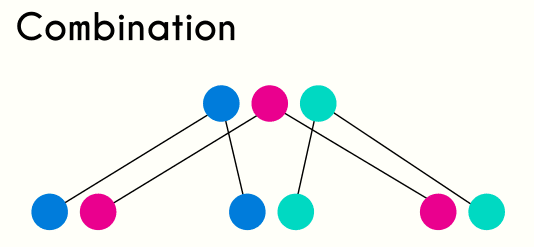Combination: with and without repetition, formula and examples
This article will be about The combination and when is it used, the types of combination, with formulas and examples of both types of combination.
Definition of combination
The combination is a method used is statistics, which consist in finding the ways we can pick some elements from a data set. The general concept of combination and permutation are pretty similar and because of that at first we cannot see the difference of between the two, but, the difference between the combination and permutation is that in the combination the order of the elements does not matter, this means that as long as the combination of picked elements are the same, this will be counted as only one combination.
To understand better the meaning and the use of the combination we are going to show the following example: If between 5 people we want to randomly choose two of them to participate in an act, in the permutation the order in which we pick the people would matter, for example, if we first pick the person A, and then the person B, this would one permutation, and if we pick the person B and then the person A, this would be another permutation, but in combination, this two scenarios would count only as one combination, no matter if the selection order is “A and B” or “B and A”

A combination is written by the letters nCr, where “n” is the number of elements of a set, and “r” is the number of elements we are going to pick, where “r” cannot be major than “n”, because this would produce an error.
Another property about the combination is that there are two types of combinations, one with repetition, and another one without repetition.
Combination with repetition
This is when the elements of a set can be repeated, to clarify this type, here is an example: A person goes to a candy shop, where there are 10 different flavors of candy, but this person is only going to take 4, one for each one of his children, this is an example of combination with repetition, because although there are 10 different flavors, anything disallows this person to pick the same flavor twice, trice or even four times.
Formula with repetition
- nCr = (n + r-1)!r! * (n-1)!
Combination without repetition
It is when the elements of a set cannot be repeated, for example: in a company where there work 20 people they take a decision of forming a directive composed by 3 people, in this case we would have a combination without repetition, because a person cannot be chosen twice.
Formula without repetition
- nCr = n!(n-r)! * r!
In combination, the most common type of combination is the combination without repetition because it is easier to find situation where the elements cannot be repeated.
Examples of combination
Example 1: A person is going to a candy shop where there are 8 types of flavors, if this person is only going to buy 3, define every combination possible
With repetition n = 8 r = 3 nCr = ?
- nCr = (n + r-1)!r! * (n-1)!
- 8C3 = (8 + 3-1)!3! * (8-1)!
- 8C3 = (10)!3! * 7!
- 8C3 = 10 * 9 * 8 *
7!3! *7! - 8C3 = 10 * 9 * 83!
- 8C3 = 10 * 9 * 83*2*1
- 8C3 = 7206
- 8C3 = 120
Example 2: 2 girls will go to a party, if between the two, they have 4 pairs of fancy shoes, define the combination of shoes this two girls can wear
Without repetition n = 4 r = 2 nCr = ?
- 4C2 = n!(n-r)! * r!
- 4C2 = 4!(4-2)! * 2!
- 4C2 = 4*3*2*12*1 * 2*1
- 4C2 = 244
- 4C2 = 6
Example 3: A man will go on a trip for 3 days, so he will take with him 3 shirts, if he has 7 shirts, how many combination of shirts can he take.
Without repetition n = 7 r = 3 nCr = ?
- nCr = n!(n-r)! * r!
- 7C3= 7!(7-3)! * 3!
- 7C3= 7!4! * 3!
- 7C3= 7*6*5*4!4! * 3!
- 7C3= 7*6*5*
4!4!* 3! - 7C3= 7*6*53!
- 7C3= 7*6*53*2*1
- 7C3= 2106
- 7C3= 35
Example 4: In a bucket there are 10 balls, every ball is numbered from 1 to 10, if somebody pulls out 3 of this balls randomly, how many combination of could he take.
Without repetition n = 10 r = 3 nCr = ?
- nCr = n!(n-r)! * r!
- 10C3 = 10!(10-3)! * 3!
- 10C3 = 10!7! * 3!
- 10C3 = 10*9*8*7!7! * 3!
- 10C3 = 10*9*8*
7!7!* 3! - 10C3 = 10*9*83!
- 10C3 = 7206
- 10C3 = 7206
- 10C3 = 120
Example 5: A sportsman goes to the store to buy 4 pairs of shoes, if at the store there are a lot of shoes in 5 available colors, how many combination of colors can this man buy.
With repetition n = 5 r = 4 nCr = ?
- nCr = (n + r-1)!r! * (n-1)!
- 5C4 = (5 + 4-1)!4! * (5-1)!
- 5C4 = 8!4! * 4!
- 5C4 = 8*7*6*5*4!4! * 4!
- 5C4 = 8*7*6*5*
4!4! *4! - 5C4 = 16804*3*2*1
- 5C4 = 168024
- 5C4 = 70